Building an MVP for Apps Focused on Messaging

We’ve mentioned communications and minimum viable product (MVP) a lot on this blog lately. Taking stock of that all, we’d like to dedicate this post to MVP for apps focused on instant messaging. Such apps have gained massive popularity, currently beating SMS and on their way to overtaking phone calls.
WhatsApp and Facebook Messenger are the most popular real-time chat apps, with billions of active users worldwide. LINE, Skype, Snapchat, Telegram, Tencent QQ Mobile, Viber, and WeChat have user bases of millions, which is still no less impressive. Every chat app creates immense marketing opportunities for various businesses.
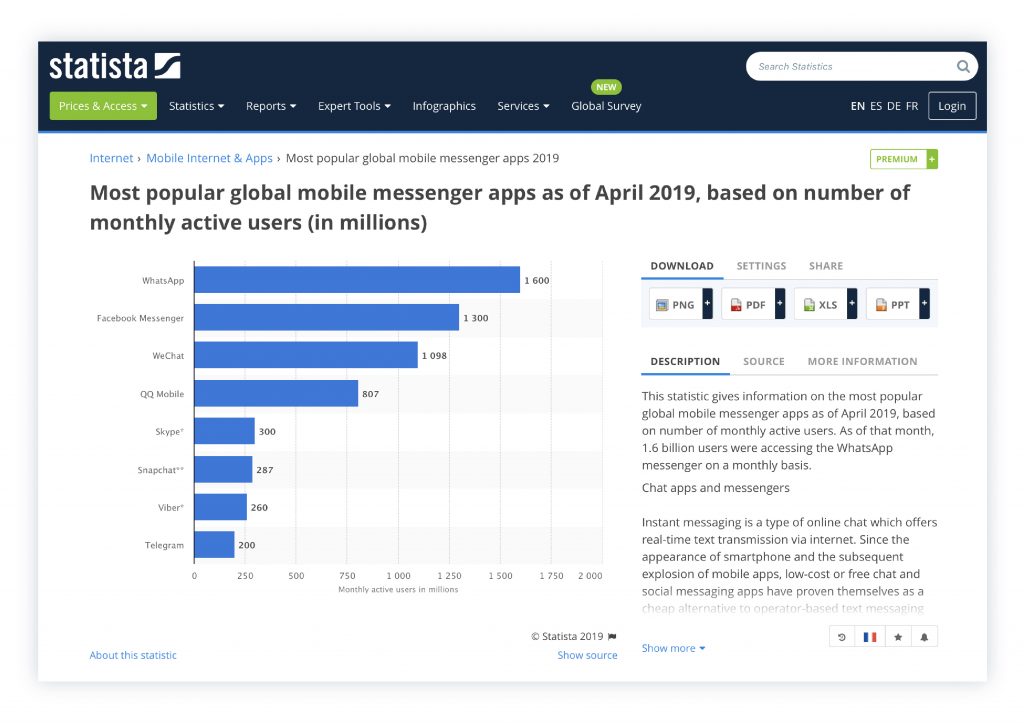
Messaging apps are gradually replacing social media as the go-tos for customer communications. Such apps are great at streamlining customer service and sales, and more of them are expected to be embracing chatbots. Moreover, the market demonstrates continuous evolution, so there’s still a chance to create a chat app that might get a decent market share or become a unique instrument for growing your business.
Whatever your plan is, it’s best to start with an MVP. This article will list the must-have features and basic steps of such an MVP app development. (If you have an application already and feel it’s time to enrich the user experience with instant messaging, the article should still be useful.) Finally, we’ll try to estimate the cost.
Why It Makes Sense to Create a Chat App or Feature
A company might want a custom chat application for numerous reasons. Primarily, such an app can:
- promote and streamline communication within an organization;
- allow instant sharing of corporate news, alerts, and other information with the employees;
- enable managers to assign tasks to individuals or groups quickly;
- facilitate task management and work progress tracking;
- help to stay in touch with team members and clients from anywhere;
- enable salespeople to connect with customers on the fly;
- let customer service stay connected with customers 24/7, collect feedback, and solve the queries instantly;
- allow team members and clients to make voice or video calls with just one tap at low costs;
… and much more. Since there’s a growing demand for connecting teams and clients in a secure chatting space, eventually you may sell the software as a service to other companies.
If you have a live mobile application without instant messaging yet, the functionality may be a valuable addition. The ability to communicate without having to exchange contact information is particularly useful for social networks, dating apps, online marketplaces, and collaboration tools. In-app chat can also give your product the competitive edge over similar apps.
If your ambition is to create a chat app that’ll become the next WhatsApp, but you doubt it’s feasible, look at WhatsApp itself. The success of this messenger is a combination of hard work, unique historical conditions, and some luck.
The company was founded ten years ago by Brian Acton and Jan Koum. Fascinated with the possibilities of the nascent mobile app industry, they envisioned a messaging app that should show statuses next to people’s names. They called it WhatsApp to sound like “what’s up.” After recruiting an iPhone developer, they incorporated WhatsApp Inc. in California in February 2009.
The project did not always go smoothly. The early versions kept crashing, so the creators considered giving the whole thing up. However, in June 2009, Apple launched push notifications. The team incorporated the novelty into WhatsApp: when a user’s status changed, everyone in their network would be notified. The number of users suddenly hiked to 250,000. Then, the creators managed to obtain seed funding from former colleagues.
In November 2009, after months at the beta stage, the app was launched on the App Store. In December, the ability to send photos was added. A BlackBerry version of the app developed by a friend followed. By early 2011, WhatsApp was among the top 20 at the U.S. App Store. Sequoia Capital invested $8 million for more than 15% of the company. By February 2013, the app had about 200 million active users. In December of the same year, 400 million users were reported. Sequoia invested another $50 million. In 2014, five years after the incorporation, WhatsApp was acquired by Facebook for almost $20 billion.
That’s one of the possible scenarios: the product becomes successful, and in a few years, the creators cash out in millions. Alternatively, you can continue growing and earning money in various ways: a popular chat app creates lots of monetization opportunities (more about it in subsequent chapters).
Although the world seems to be divided between a handful of giants, it still provides a chance for high-quality products with original features. There’s an insatiable demand for reliable personal and business communication channels. Our changing world demands new solutions. Most users have at least two messengers installed on their smartphones and are quick to switch to a new service if it’s better at meeting their needs. This means there is a space for your ideas too.
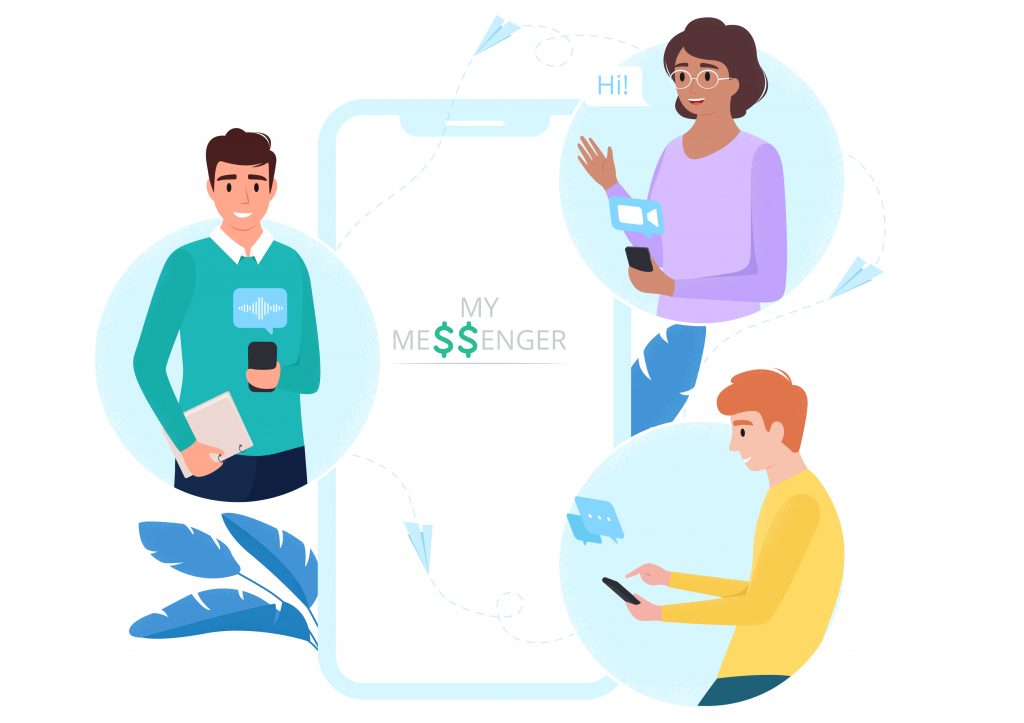
Back in 2009, nobody could’ve predicted that WhatsApp would become the fastest growing app ever. Nobody can do so for your MVP mobile app either. Luckily, tech entrepreneurs and enthusiasts nowadays can learn from the experiences of others and have some best practices and tips to follow.
Essential Components of an MVP for Apps Focused on Messaging
Your MVP mobile app must have a relevant set of features that solve a core problem for a group of users. If you select the wrong/irrelevant features or too many for version one, you risk losing both time and money. If you create an MVP with the bare minimum required for texting, it may not work either. Modern users expect to be able to do much more, and the most demanded features already exist in the most popular messengers.
Therefore, a list of features to implement even during the MVP app development may be pretty long. We’ve divided must-have functionalities into basic categories, but the final list still depends on each product’s specific
Registration
A seamless onboarding experience is imperative. The user authentication can be implemented in several ways: via the phone number, email, or social network accounts. If you can’t let users choose the authorization method, at least pick the one that is most suitable for your target audience. For example, most popular messengers require users to sign in with a phone number, sending an SMS confirmation code for security purposes. It’s easy to start using such apps, but users can’t use the same account on multiple devices.
After registration, users can create profiles (with varying management and customization abilities) where they can add personal information and photo.
Contacts
Most people install a particular messenger to be closer to friends who already use it. The more contacts they have in a messenger, the more often they’ll use it. Make the contact integration quick and convenient. Good user experience implies importing contacts from the contact book automatically. Show the users who else from their contact book is using the app. Offer the ability to send invites to friends, to search for friends who may not be on the contact book but also use the app, and to share contacts in the app.
If the app doesn’t provide for registration via the phone number, access to the contact book isn’t necessary. In this case, you can let users search for contacts by email or other parameters.
Instant messaging
The core feature can be implemented in two ways. In the first case, the messages will be stored on a server. Communication between the server and users will happen via the HTTPS protocol with SSL cryptography. For real-time messaging, it’s necessary to reduce the polling interval to 1-2 seconds. This method may also include additional cryptography so that a message goes from the server to the recipient in an encrypted form.
With the second method, messages aren’t stored on the server. Only the central server does the authentication. After that, each message is encrypted by the asymmetric cryptography algorithm and delivered to the recipient through the wireless mesh network.
If users go offline, they should be able to receive all the messages they missed as soon as they’re online again. Let them see who’s online, when a contact last used the app, and when they’re typing. Message statuses (delivered, failed, seen, or edited) are another standard feature.
Will your end-users appreciate the ability to leave messages at any time without typing everything out? If “Yes,”, consider implementing voice messaging.
Group chats
Depending on the end-users’ needs, consider offering both public and private chats, an ability to create sub-groups, sharing files with selected group members, private replies, creation of channels, and other group-related features.
Security features
Give special attention to privacy and prevention of hacking activities, collection and stealing of personal data, and identity theft. Encryption is desirable for all users, but if your messaging app is intended for a business or organization, the security requirements are particularly high.
Cloud messages is a standard encryption method. For better data protection, some messaging apps use end-to-end encryption (E2EE). WhatsApp uses a system which scrambles all messages, and the recipients have the keys for deciphering the content. This precludes any third party, including WhatsApp itself, from reading your messages. In case a user’s message is intercepted and decrypted, Telegram prevents hacking all other messages by regularly changing cryptographic keys. If needed, implement more security features on your chat app, e.g., ban for forwarding messages to persons outside the secret chat, notifications about taken screenshots, etc.
Conversation history
Most chat apps are expected to store conversation history. Chat histories and files sent by users should be stored in the cloud so they can be accessed anytime from any device. Quick search should enable users to search and track conversations that took place long ago. On the other hand, the nature of your service might require that users should have more privacy and control over their data. In that case, self-destructing messages and media are more desirable.
Cloud synchronization keeps the text messages and media files sent by users and stored in different places up-to-date. A change to a file on the phone is automatically applied to all other instances of the file, e.g., on the tablet. It’s useful if the users access the app from multiple devices, or delete it accidentally, and so on. The improved user experience may become your competitive advantage over the apps that don’t have it. However, beware that cloud synchronization raises the issues of security and the speed of messages exchange.
Voice and video calls
The more communication channels you offer, the greater your user base and higher the app usage. The main options are:
- Voice calls;
- Video calls;
- Group calls with both audio and video.
For video call functionality, it’s necessary to select video and audio codecs and the way to transfer the video. The codecs must ensure a sufficient quality of video even at the minimum Internet speed. The video can be transferred either via the server or from user to user. The latter is preferable because it won’t overload your servers.
Group call functionality takes greater effort to implement and presents some difficulties for the system. However, if it fits your app’s goals and your budget allows, implement the feature.
Files transmission
People expect to be able to share photos, GIFs, videos, documents, stickers, and other content instantly. Depending on the target audience’s needs, you can:
- make your app MVP to support different data formats;
- enable the users to share documents from Dropbox or Google Drive services;
- let users send only existing files (e.g., photos and videos from the gallery) or take pictures and videos directly from the app.
(If you opt for the latter, any filters or editing functionality is still better left until later versions of your app.)
Push notifications
Notifications may inform the users when new messages have arrived, their messages are received and read, a favorite contact comes online, and so on. They can be combined with geolocation for contextual messages. They also serve for direct communication between the messenger creators and its users. Push notifications can result in 3-10 times more retention and boost user engagement. The key to success is to develop relevant and highly personalized messages and rich customization options.

This is a basic set of essential functions that will go both for public and business use. However, what is “essential” depends really on the app’s purpose and target audience. If your goal is entertainment, fancy stickers are a must even for an MVP, whereas businesses will require solutions for enterprise-level and customer-focused business communication.
The purpose of any MVP in app development is to provide immediate value quickly while minimizing development costs. The process can be divided into several steps. Let’s take a look at them in the context of a messenger MVP app development.
Steps to Create a Chat Application MVP
1. Research the market.
Decide what audience you’d like to focus on in the first place. Identify your main rivals and their competitive advantages. If you mean to compete against a popular messenger, you should first understand what people are using it, why, and how much time they spend there.
There are also demographic and geographic differences. For instance, WhatsApp users appreciate the instant integration with phone contacts, simplified sharing of media files and location, and the absence of distracting ads. WeChat, an absolute favorite in China, offers tons of abilities. The platform’s mobile payment service assists with every aspect of life: shopping, organizing doctor’s appointments, ordering food delivery, or paying an electricity bill or traffic fines.
A more specialized app for specific audiences, e.g., doctors and patients or persons with special needs, may prove to be a great idea too.
2. Understand the business needs and find the opportunity to meet them.
Determine the goals of your chat app: they should be driven by problems that need to be solved for the end-users. Create user personas that outline the needs, motivations, and pain points of people who will use your app. Determine the success criteria.
Identify the opportunities and figure out how you can most effectively add value and solve those pain points. Map out the user journeys by writing down what the user has to do to meet the goal. List and count the pains and gains for each action. The process lets you determine where you have the highest potential to resolve pains and add gains. Your MVP’s features should address those areas first. Other items can be added later in the product roadmap.
3. Prioritize the features to include into the MVP.
This step basically helps you to decide where your product can make the most impact in relation to the urgency of the feature, the organization’s effort, etc. Prioritization matrices provide one of the ways to do it.
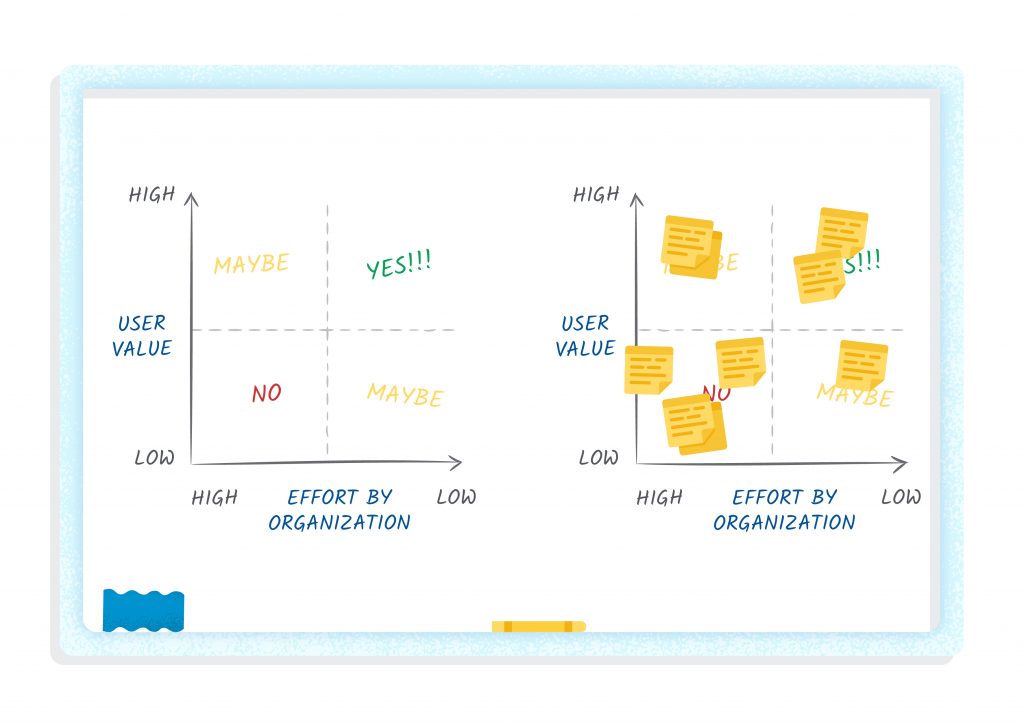
It’s a good practice to include the cost of development for each of the features when you make the final decision on what your MVP absolutely needs to include. The monetization strategy you choose will influence the selection as well.
4. Develop the monetization strategy for your MVP mobile app.
In the long run, the success of your product will be measured by the revenue it generates. Most messaging applications are free but are capable of making money thanks to smart monetization strategies. Some of the most popular options are:
In-app purchases
You can make a profit by selling customization options, such as wallpapers, themes, filters, games, etc. The items have to be really cool to pay for.
Stickers are one of the top monetization options for real-time chat apps. LINE has been offering basic, animated, sound, and pop-up stickers since 2011. Some stickers are free to get users hooked; others are sold in packs for a modest price. In 2014, LINE introduced a platform where users can create and sell their stickers. Three years ago, it was reported that the company was earning over $270 million a year from stickers sales. As of April 2019, the stickers are sent 433 million times/day on average, and there are approximately 4.7 million sets available. The same month, Custom Stickers went on sale, allowing LINE users to personalize and create original ones.
LINE and several other messengers also offer games that can be played directly from the chat threads. The revenue comes from the sales of game currency, experiences, or items that help users progress in the game.
Advertising
In-app ads are Snapchat’s primary source of revenue. Facebook is putting ads in Messenger, and WhatsApp is preparing for advertising in 2020. The monetization strategy is so attractive because it enables thousands of marketers to reach millions of active users daily.
One way is to display in-app ads (such as promotional banners or in-line ads) and get paid when users interact with them. You can also enable users to create and publish own ads and charge for this service.
If advertising fits your business model, you can try it with your MVP mobile app. Just use ads with care. The key to success is not to overload the app with ads and not to interrupt the core chat experience. If you’re concerned about users being annoyed, provide the option to turn ads off.
Subscription
WhatsApp used to cost 99 cents annually (after a one-year free trial) but then gave up this monetization model. A paid app that has just been released can hardly compete with free big players in the market. You can add a subscription fee eventually, though, when your user base is large enough and really hooked on your messenger. Paying users might then access premium features, disable advertising, or otherwise improve their app experience or business opportunities.
Some messengers offer businesses an opportunity to create paid official accounts that help them connect with their clients. WhatsApp Business is a part of this strategy. Small businesses can set up profiles with useful info and answer customer requests. All replies are free if sent within 24 hours. Afterward, WhatsApp charges a fixed fee per late message.
Online payments
Several messengers let users shop in the apps. WeChat charges a percentage for each transaction. Telegram is about to launch its blockchain platform and cryptocurrency, turning the app into a full-fledged payment system.
Sponsorship
Sponsorship entails partnering with marketers or investors. For instance, branded stickers can promote a company’s upcoming products. Or it can fund rewards for users who complete certain in-app actions. The app obtains more engaged users and earns money by taking a percentage of the revenue from redeemed rewards.
Any monetization strategy will work better if it’s in line with the app’s objective.
5. Pick the platform(s) to create the MVP mobile app for.
Due to budget and time limitations, app creators usually have to choose one or two platforms to launch the MVP on. Your chat app can be native, hybrid, or cross-platform native. We don’t recommend building a hybrid app, except as a quick prototype. In most cases, it’s reasonable to create chat app for Android users first.
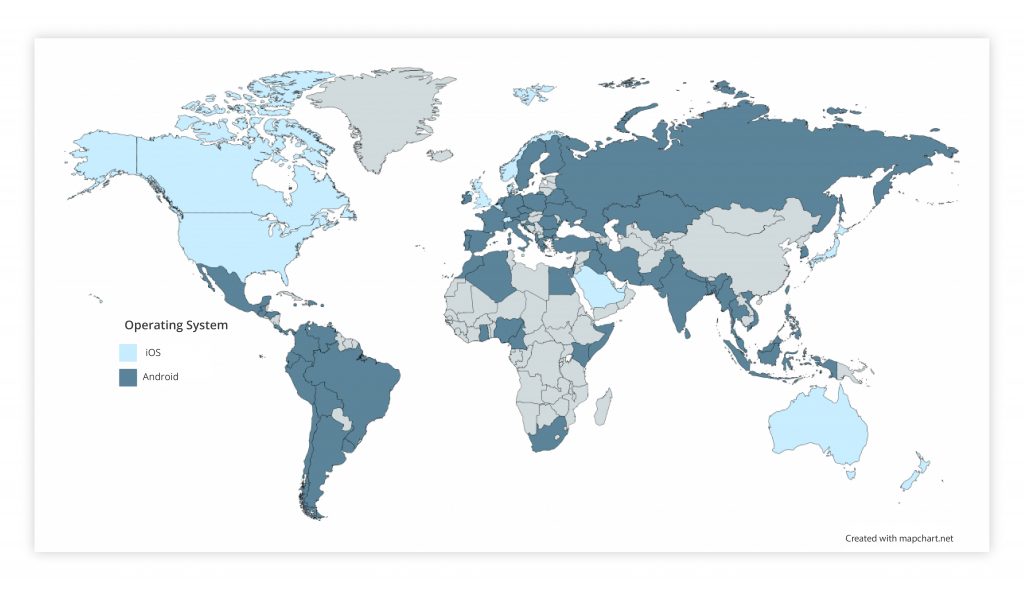
Image source
6. Engage a competent and reliable team/software development company.
The size of the team depends on the size of the project. The must-have list of specialists includes a designer for the user experience and user interface (UX/UI), a project manager, software engineers for the frontend and backend of your application, and QA engineer(s). Don’t forget about security and compliance specialists to ensure full transparency in data handling and processing and GDPR compliance.
Make sure the team includes experts who have the experience in instant messaging app development. They should know how to create a reliable platform with the possibility to scale up and add features in the future.
7. Have your messaging app designed, developed, and tested.
You’ll have only one chance to impress the users with your product’s look-and-feel. A minimalistic approach to the UX/UI is the best for chat apps. The design must be clear-cut and intuitive, as proved by Messenger or WhatsApp. Even the app’s icon on the users’ home screen will be important. Hire professional designers who have years of experience, are familiar with dozens of chat interfaces available on the market, and keep abreast of latest app design trends.
Ideally, the development company you partner with should take care of the UI/UX design as well. The project will proceed faster (and cost less) if all are working under one roof.
The core functionality, or the backend, of a messaging app will involve infrastructure like RestFul API, databases, storage servers, messaging protocols like XMPP, notification services, etc. Chat apps handle millions of requests daily and require extra reliability and 100% uptime.
The tech stack that you’ll need may vary depending on the platform you’ve chosen, the app’s complexity, and various functionalities it may include. Are you going to create a chat app from scratch, i.e., writing the whole code, or will you be using online tools, APIs, protocols, and libraries? The second option will speed up the MVP app development significantly.
Image: Technology Stack to Create Chat App for Android and iOS (Front-end)
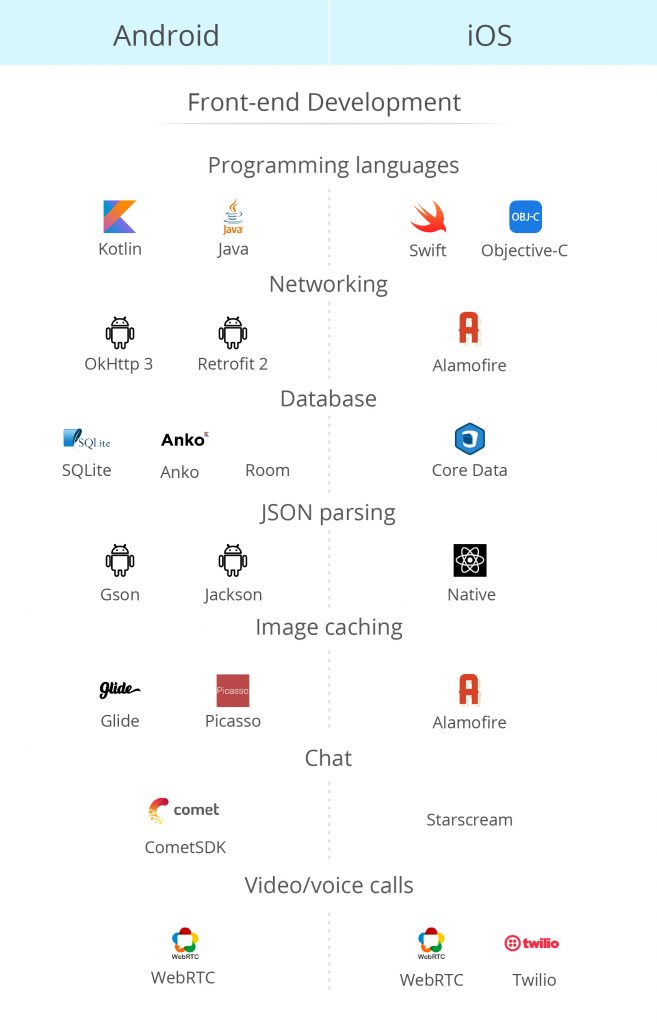
Image: Technology Stack to Create Chat App for Android and iOS (Back-end)
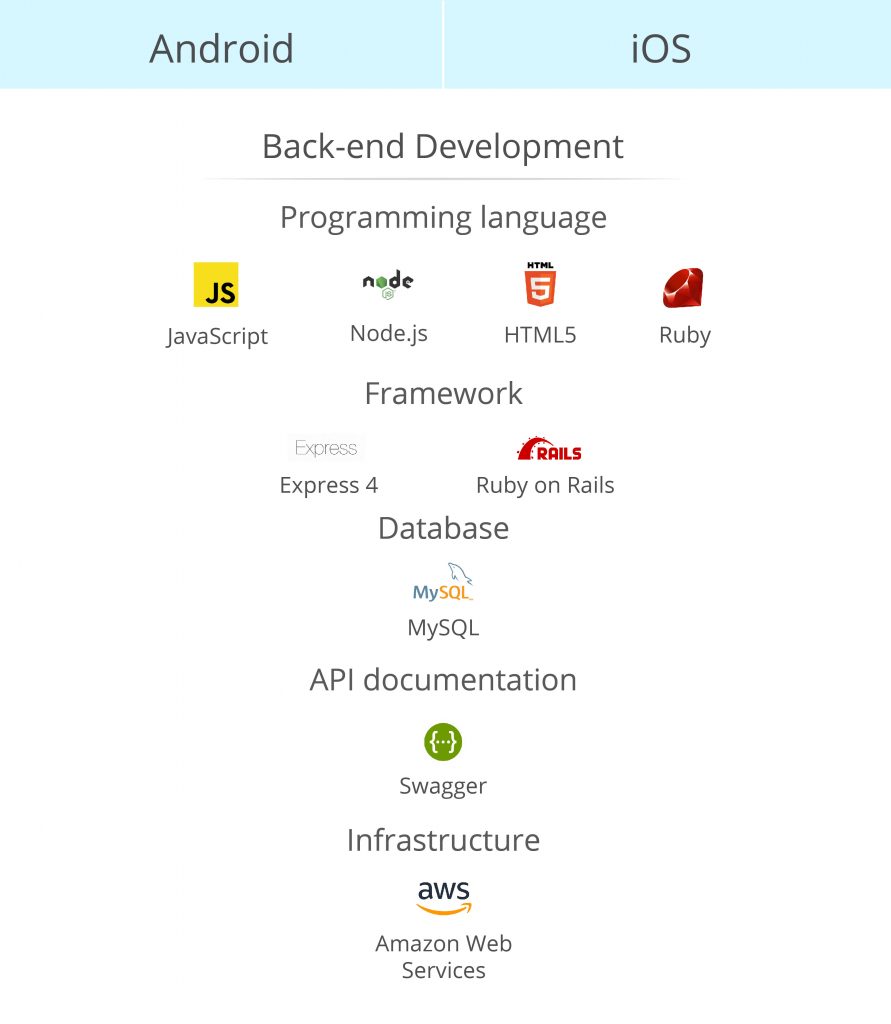
Image: Third-party Services for Android and iOS Chat Apps

It’s essential to test both the usability and design of your product. Take another round of development to fix all the imperfections.
Simultaneously with the MVP app development, you’ll have to draw up a marketing strategy, starting from pre-launch app marketing, app store optimization, and then further means of engaging and attracting users. Launch a marketing campaign before the app’s release.
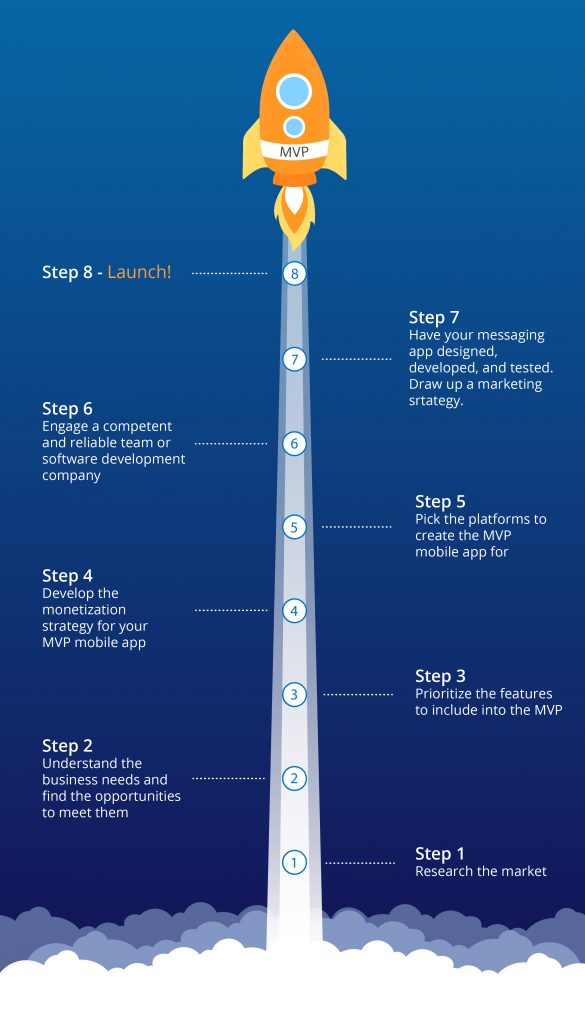
After your MVP mobile app is published, you can start earning money and collecting the users’ feedback. Monitor analytics and track user behavior to establish what app features drive usage. Soon, you will see what works, what doesn’t, and what you need to make your offer unique. You will be gradually fixing the bugs, improving on the app, complementing it with new features, and scaling up. Simultaneously, start the development of versions for the web and other operating systems.
Some of the functions you may add to subsequent versions of your chat application may include:
- Location tracking
- Stories or other temporary content
- Scheduling messages in advance (e.g., for birthdays and holidays)
- Calendar synchronization
- Secret secure chats with self-destructing messages
- Use of emails & SMS
- Spam control and ban policy
- Video streaming function
- In-app purchases
- Stickers (including user-created stickers)
- Personalization features
- E-commerce functionality
- Payment integration
- AR functionality for business messaging that will help to showcase the products
- A platform for chatbots (the ability to have bots that can facilitate sales or provide customer support will attract businesses to your app)
The Cost of a Messenger MVP App Development
If you google such an MVP app development cost, you’ll probably see figures like “starting from $20K” and “up to $223K for an app like WhatsApp.” Unfortunately, there’s no single accurate number. For the basic MVP features listed in this article, the following estimate can be made:
Image: Approximate Time Required to Create Chat App for Android or iOS
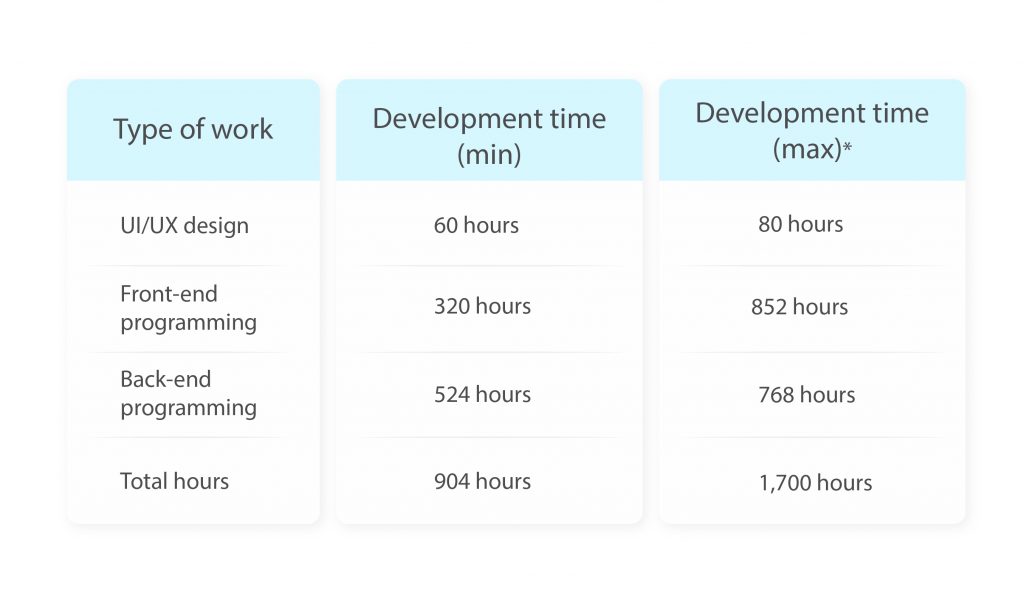
* Like with the price of any mobile app development, it all differs and depends. The factors that can contribute to the project timeline and cost include, but may not be limited to:
- the required functionalities and features
- number of screens
- choice of the platform(s) / technology / devices the app will run on
- UX/UI design requirements
- amount of testing and refinement required
- number of people working on the product
You can estimate the total cost of your MVP mobile app by multiplying those numbers by an hourly rate of the specialists that will be realizing the project. You can hardly manipulate the business objectives, the platform, the required functionality, and app quality, but outsourcing the design, development, and testing tasks can help reduce the cost significantly.
Remember that MVPs are there for testing ideas, market needs, customer behavior, and product-related risks with minimum effort. An MVP mobile app will still be cheaper than a full-fledged product with sophisticated features and nuanced customizable UI design.
Wrapping Up
Real-time chat apps have changed the way we communicate and are changing the way we sell and buy things. Companies building a chat app create a million opportunities and benefits for the employees, partners, clients, and prospects they may not know yet. Telegram’s success shows that the messengers market still has room for new players and ideas.
Every journey starts with the first step. Whether you’re about to add messaging functionality to your existing mobile application, or to create a chat app for your enterprise, or to build an entire new platform, it’s better to start with an MVP as the initial product version. The approach is especially relevant for startups. MVP app development demands smaller investment, helps reduce business risks, and facilitates fast real users’ feedback.
The time it takes to develop a messaging app depends on many factors, starting with the number of features. An MVP for apps like Messenger or WhatsApp naturally must have the essential benefits of the competitors, but you should know what your customers need in the first place. It’s OK to look up to the leaders, but you should find your way. Focus on excellent user experience and try to enhance it with additional unique features and design that would grab the users’ attention.
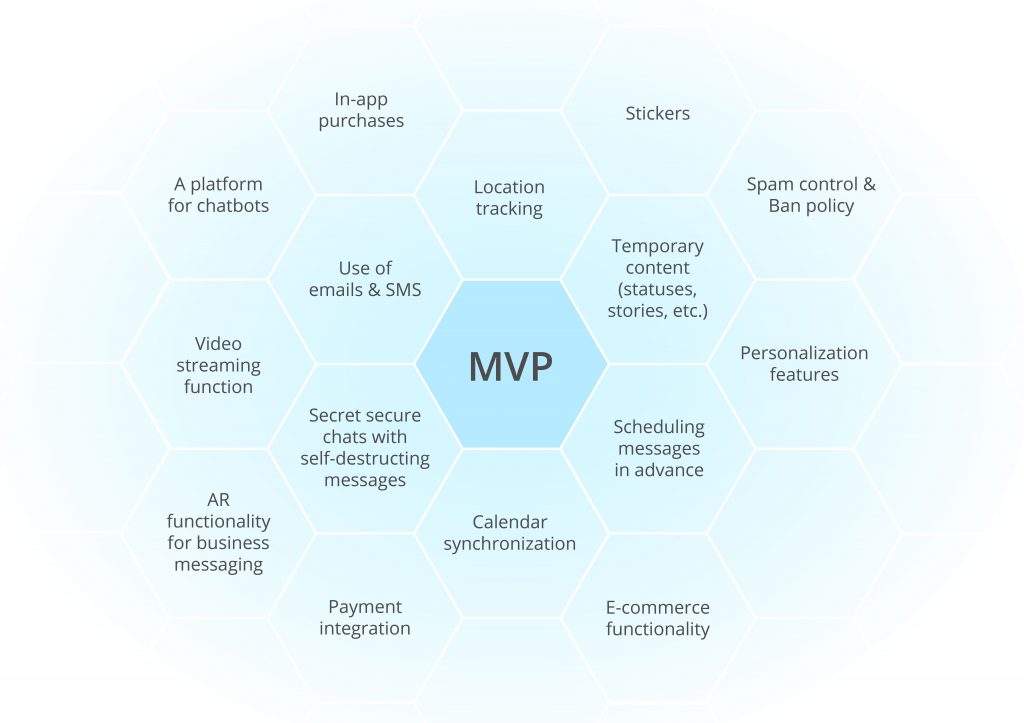
Whatever features you have to implement, it takes competent and reliable software developers to build them properly. Alternative-spaces’ mobile application developers have all the expertise and extensive experience in instant messaging application development. Our teams helped create apps for clients from all over the world. If you need advice or look for dedicated professionals to create a chat app for Android or iOS — contact us!
Content created by our partner, Onix-systems.
 Home
Home